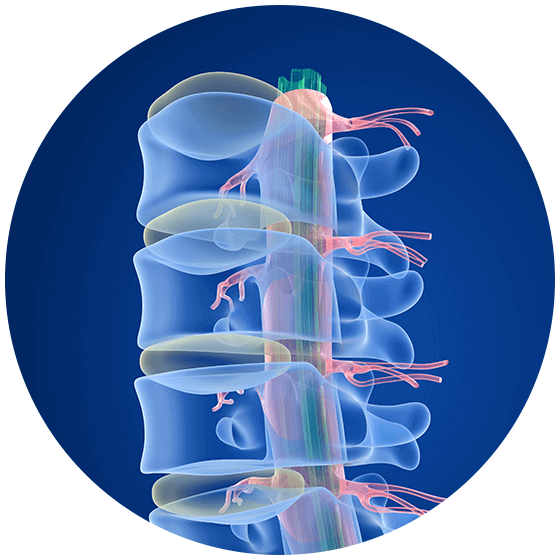Bulging Disc

Bulging Disc Symptoms & Treatment Options
In addition to the 24 vertebrae of the spine, your spine also consists of 23 spinal discs. These “intervertebral” discs sit between each pair of vertebrae in your spine, like the meat in a sandwich.
A bulging disc occurs when a spinal disc (i.e. the meat) suffers damage and balloons outward from its perimeter, extending beyond the vertebrae (i.e. the bread).
This can occur for any number of reasons, but the primary culprit is everyday wear and tear.
Keep in mind that these discs serve two primary purposes. Firstly, they provide your spine with the elasticity that it needs to move. And, secondly, they absorb the subtle shocks that this movement can create as we go about our daily lives. But, this shock absorption comes at a high cost. It means that our intervertebral discs are also particularly prone to injury.
When a spinal disc develops even a minuscule tear, it alters the anatomy of the disc. A healthy spinal disc consists of a tough exterior (known as the annulus fibrosus) and a gelatinous interior (known as the nucleus pulposus). A scratch on the surface of the disc causes the liquid interior of the disc to rush toward the point of exterior weakness. This creates a protrusion on the disc wall, known as a bulging disc.
If the pressure inside the disc becomes too great, then the nucleus pulposus can breach its container. Known as a slipped or herniated disc, this phenomenon occurs when a spinal disc ruptures.
However, both herniated and bulging discs can cause similar symptoms–or no symptoms at all. The consequences that we experience occur when the disc presses against a spinal nerve root. Then, we can experience symptoms such as pain, numbness, or muscle weakness.
If you or someone you know is experiencing a bulging disc, general symptoms of a bulging disc often include:
Local pain at the site of the bulging disc
Radiating pain that extends into the arms or legs
Neurological symptoms, such as searing pain, tingling, or numbness
Pain that intensifies with strenuous activity
Pain that abates when you stand upright with good posture
Muscular weakness, cramping, or spasms
Symptoms of a Bulging Disc
If you have been diagnosed with a bulging disc, then your symptoms will vary according to the region of your spine that is affected. For example, if your bulging disc compresses nerve tissue in your cervical spine, then you may experience symptoms such as arm weakness. However, if your bulging disc pinches nerves in your thoracic spine, then you may experience pain in a band that encircles your chest. And, if your protruding disc affects nerves that extend from your lumbar spine, then you may experience tingling in your legs and feet.
If these symptoms sound a little too familiar, then it’s time to contact a board-certified spine expert. The symptoms of a bulging disc can mimic other conditions of the spine. So, achieving an accurate diagnosis is key. For professional advice that you can trust, contact our fellowship-trained spine specialists at the Advanced Spine Center of NJ! Our board-certified physicians use the latest advancements in minimally invasive care to diagnose and treat your condition!
Causes & Consequences of a Bulging Disc
Many different factors can cause a herniated disc. However, three of the most common conditions that lead to bulging discs include spinal injuries, bone spurs, and degenerative disc disease.
Spinal Injuries: Spinal injuries can cause a lifetime’s worth of wear and tear on the spine to occur in an instant. High risks events for a bulging disc include falls, car accidents, sports injuries, and occupational mishaps.
Bone Spurs: Bone spurs are bony protrusions that form along the edges of joints as the body attempts to lessen the effects of osteoarthritis. Because bone spurs can grow into the disc space, they often cause bulging or prolapsed discs.
Degenerative Disc Disease (DDD): DDD occurs over the course of many years, as our discs begin to dehydrate from the aging process. With less liquid left inside the disc, the exterior of the disc can harden and crack. These micro-tears can lead to bulging or collapsed discs.
In addition, a bulging disc can lead to many different complications of its own. However, spinal stenosis is one of the most common conditions that can arise. Spinal stenosis occurs when a bulging or herniated disc pinches the spinal cord. Unlike simple nerve compression, a pinched spinal cord can lead to temporary or permanent paralysis. If you begin to display symptoms such as numbness in the groin region or incontinence, then seek medical attention ASAP. If ignored, these symptoms can lead to irreversible nerve damage.